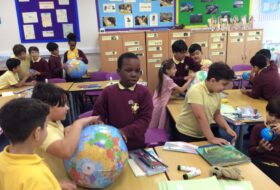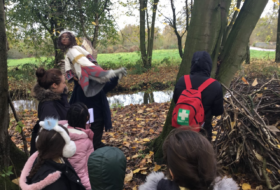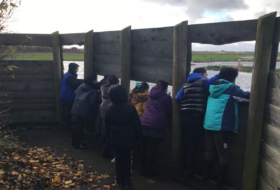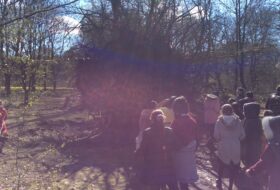CURRICULUM
Geography
Geography Curriculum Statement
At St Hugh’s Catholic Primary School, we want to inspire children to become fascinated and curious about the world they live in. We aim to equip our learners with knowledge about diverse places, people and environments. Through a carefully sequenced curriculum, children build on prior knowledge to understand how landscapes are formed and of the interaction between human and physical processes.
In Key Stage 1 children develop their knowledge of the world, the United Kingdom and the local area. They begin by learning to name and locate the continents and oceans on maps, as well as describing human and physical characteristics of an environment. As their understanding develops, they have the opportunity to observe the local area first hand by carrying out field work in and around the school, drawing sketch maps and looking at aerial photographs. They learn how to use maps, atlases and globes and learn simple compass directions. Children then identify hot and cold places in our world and compare the Lake District in the UK to the Rockies in the USA.
In Key Stage 2 children build on what they already know and extend their knowledge beyond their local area to include the UK, Europe and North and South America. They examine the similarities and differences of human geography across the world such as: types of settlement and land use; the distribution of natural resources; economic activity including trade links. They will also study physical geography elements such as: climate zones, biomes and vegetation belts; rivers, mountains and the water cycle; volcanoes and earthquakes. Children use a wider variety of maps, atlases and globes and use the 8 points of the compass in their work. They learn how to use four and six figure grid references and ordinance survey maps. Field work includes collecting information such as land use around our local parks and presenting this information using a range of methods.
Each topic has a key question to get children engaged and to evaluate their progress through written work and responses in classroom discussions.
Geography Subject Plan 2024-25
Year 6
We went on a trip to the Liverpool Museum to learn all about the River Mersey and how it has helped shape Liverpool. We saw the ferry crossing the Mersey, explored the museum with a guide and then learned about important imports and exports. Finally, we shared everything we had learned with the rest of the class!



Year 5
We learned about how different types of mountains are formed. They then used globes and atlases to locate examples in the world.



Year 4
Year 4 went on a visit to Martin Mere Wetlands and Bird Sanctuary to help them deepen their understanding in their Geography and Science lessons. We explored habitats and learned about the many different species found there (science) and discovered more about the physical geography of the area that makes it possible for the animals to survive (geography).



Year 5
For our topic on fieldwork in Geography we went to Sefton Park on a very beautiful and sunny day. We used maps to figure out where we were and looked at the human and physical characteristics. We found a huge tree that had fallen down and investigated what happened to it!



